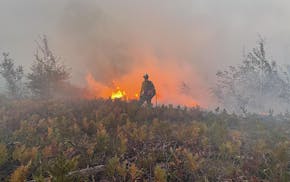Minnesota's second COVID-19 pandemic wave is showing signs of leveling off, with 359 lab-confirmed infections reported Tuesday with the novel coronavirus that causes the infectious disease.
While daily numbers reported on Tuesdays have typically been lower, reflecting reduced testing and diagnostic activity on weekends, that is one of the lowest numbers in weeks and reflects broader trend data.
Minnesota's 14-day rolling average of daily confirmed cases has declined 14% from an average of 697 cases per day earlier in August to 600 now, according to the COVID Exit Strategy website.
The positivity rate of diagnostic tests had increased from 3% in mid-June to nearly 6% earlier this month, but has settled back at 4.9%, according to the latest state Health Department data.
The timing at least coincides with the state indoor mask-wearing mandate that took effect July 25, because it often takes two to four weeks before any public health strategies or major events in the pandemic show up in case numbers. State Health Commissioner Jan Malcolm said there is no way to prove if the mandate made a difference, though.
"It's often really hard if not impossible to pin down precisely which interventions had which percentage of effect," Malcolm said, "but certainly the fact that we've seen a stabilization in our cases and even a trend downward certainly coincides in time with what we would expect to see from the mask mandate."
The state also reported nine COVID-19 deaths on Tuesday and 304 hospitalizations — an increase of 18 from Monday. That included 154 people in intensive care due to breathing problems or other complications from their infections.
Daily COVID-19 hospitalization and death figures have remained fairly stable since the start of July. Health officials had worried that case growth this summer — following the limited reopening on June 10 of indoor restaurants, bars, fitness centers and entertainment venues — would eventually result in the same growth in deaths and hospitalizations in Minnesota that happened in Southern and Western states.
"If our cases had continued not only to be at a high level but continued to grow at an accelerating rate — that was certainly the scenario we saw in some other states that we were hoping to avoid," Malcolm said, "and that was part of the mask mandate decision."
Boy, 16, shot at YMCA in Coon Rapids

Federal funds to help restore Lake Superior sandbar

Brooks: Only you can prevent wildfires, Minnesota
Brooklyn Park police ask for help in search for man suspected of sexual assault at gunpoint

